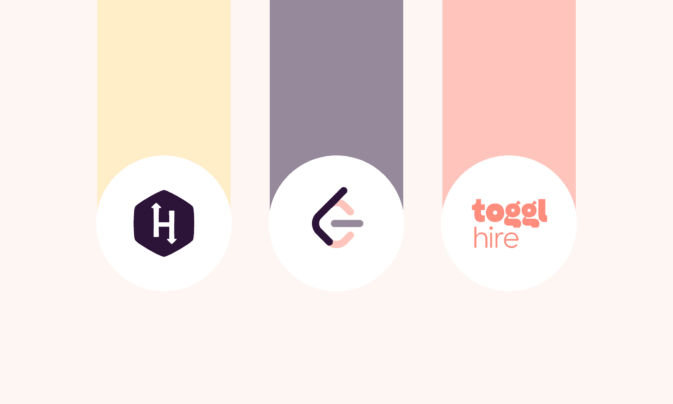Unconscious biases impact hiring decisions. Gender, age, university degree, or ethnic background influence our first opinion about candidates — and not always in a good way.
Statistically, job applicants from minority ethnic backgrounds need to send 60% more applications to get a positive response. Among workers aged 50-69, 36% feel disadvantaged when applying for jobs due to their age.
Blind recruitment software removes sensitive information from candidate applications, allowing managers to make decisions based on experience and skills rather than ancillary demographic factors. The following six blind hiring tools help create a fairer, merit-based recruiting process.
TL;DR – Key Takeaways
- Blind hiring software removes personal details from job applications and keeps the focus on skills and qualifications, so the only bias is in favor of talent and the most qualified candidates.
- You’ll find different blind hiring tools for different purposes. Tools like Toggl Hire and Pymetrics help evaluate applicants based on their skills rather than resume-listed qualifications, while tools like Pinpoint and TalVista help anonymize candidate profiles.
- The benefits of implementing blind hiring practices include facilitating diversity recruiting, combating unconscious bias, and increasing recruiting efficiencies while reducing hiring costs.
- Understanding how to integrate blind hiring practices into your existing recruitment strategy can help ensure your team gets the most out of the benefits of these tools.
Best blind hiring tools compared
| Software | Key Features | Free Trial | Pricing |
| Toggl Hire | • Customizable hiring pipeline • 180+ pre-made skills assessment tests • Over 200,000 expert test questions • Automatic test grading with scores • Test performance statistics • Candidate source analytics • Anti-cheating and anti-AI technology | Yes | From $49/month |
| Applied | • Inclusive job description generator • Automatic candidate anonymization • Resume/CV scoring tool • Skills-based shortlisting • Library of structured interview questions | No | On-demand |
| Gap Jumpers | • Custom test assessment questions design • Automatic assessment grading • Anti-cheating technology • Access to the company’s talent pool • Bespoke consulting on recruiting | No | On-demand |
| Pinpoint | • Full or anonymized candidate profiles • Candidate scorecards • Interview scheduling • Customizable recruiting workflows • Recruitment analytics | No | On-demand |
| TalVista | • Job description optimizer • Redacted resume screening • Structured interview planner | No | On-demand |
| Pymetrics | • Gamified soft skills assessments • Custom assessment algorithms • Predictive workforce analytics • Integrations with popular ATS platforms | No | On-demand |
1. Toggl Hire
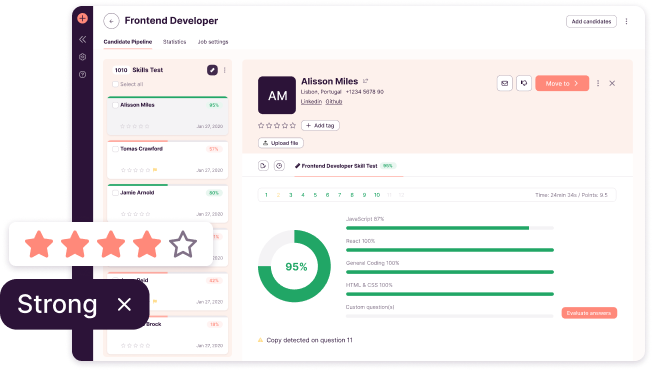
Toggl Hire is a skills-based hiring platform that offers access to over 20,000 pre-made test questions to assess qualifications for different roles. Users can create competency-based tests from pre-made templates, add custom questions, and set pass thresholds to pre-screen the best candidates for the interview.
In the context of blind recruitment, Toggl Hire helps evaluate applicants based on their skills rather than resume-listed qualifications and “bragging rights.” You can also create and send homework assignments to further evaluate the candidates’ competencies and make fact-based decisions.
Although Toggl Hire doesn’t offer full anonymization of candidate profiles, it shifts the focus from the candidates’ backgrounds to their qualifications. It also improves the candidate experience by helping companies reduce the time to hire and improve response times.
“For many roles, attitude and skills matters more than education or previous experience. Toggl Hire helped us quickly test those things before even talking to candidates”, said Emil Krzeminski, Head of International Sales at Listonic.
Using Toggl Hire test assessments, Listonic pre-screened a list of international applicants for its first remote position, prioritizing people with the right skills, attitude, and communication style.
You can try Toggl Hire for free, and paid plans start at $42/month.
2. Applied
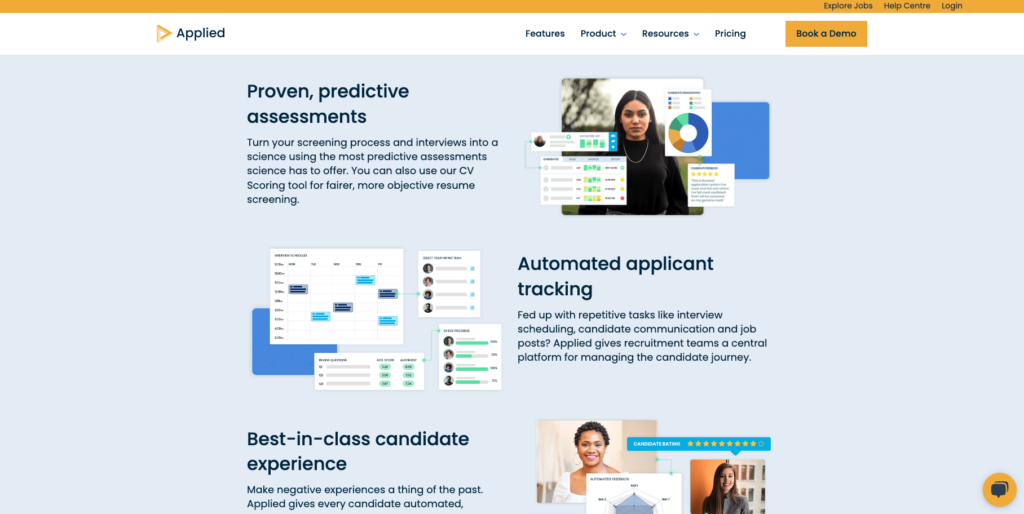
Applied is a predictive applicant tracking system (ATS) backed by behavioral science principles. The main features include an anonymous resume evaluation tool, a customizable test library, fair grading algorithms, a structured interview database, and predictive candidate shortlisting.
Like Toggl Hire, Applied provides access to a test library of behavioral science-based job simulation questions. You can also create numerical and cognitive tests to evaluate candidates‘ analytical and problem-solving skills.
All the test results are anonymized, and answers get randomized for scoring to minimize hiring bias among hiring managers. Customers positively rate Applied for high-volume hiring and DEI analytics. The downside is its high price, which is listed as starting at $5,000 per year.
Pricing details are available on request.
3. GapJumpers

GapJumpers is a recruiting advisory firm offering consulting and technology implementation services. In other words, the team first assesses your current recruiting process and goals and then helps implement the right configuration of its platform to fit your hiring process.
Like Toggl Hire and Applied, GapJumpers provides access to a database of skills assessment questions and helps users create custom ones for different roles. You can then rate candidates’ responses to create a shortlist of top talent. Test responses can be anonymized or include partial candidate data to help reduce hiring bias.
GapJumpers also offers bespoke services related to common recruitment issues most companies face in today’s hiring landscape, including everything from improving diversity by implementing a blind hiring process to assessing current employees for risk of burnout.
Pricing details are available on request.
4. Pinpoint
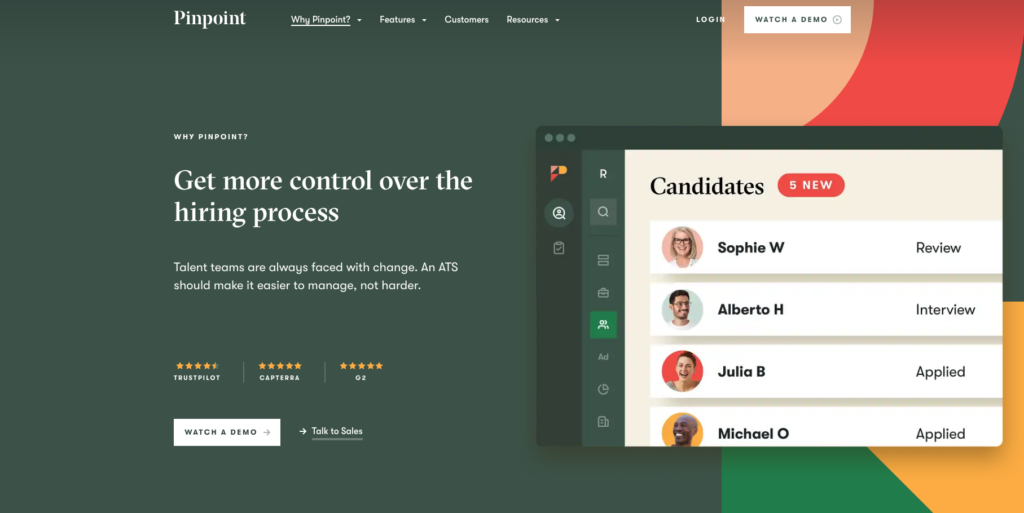
Pinpoint helps attract, hire, and onboard the right talent. It combines standard applicant tracking system features like online application forms, job requisition management, talent pools, candidate scorecards, and interview scheduling with cool add-ons like bling hiring, video interviewing, and online employee onboarding.
You can enable blind recruiting on a job-by-job basis and select which candidate details you want to anonymize and at what interview stage. Then, you can share anonymized candidate profiles with decision-makers with one click. This helps reduce hiring bias and create a more structured interview process.
Unlike the other bling hiring software on this list, Pinpoint doesn’t offer skills-based assessments, but as current customers point out, it makes resume screening fairer.
Pricing details are available on request.
5. TalVista
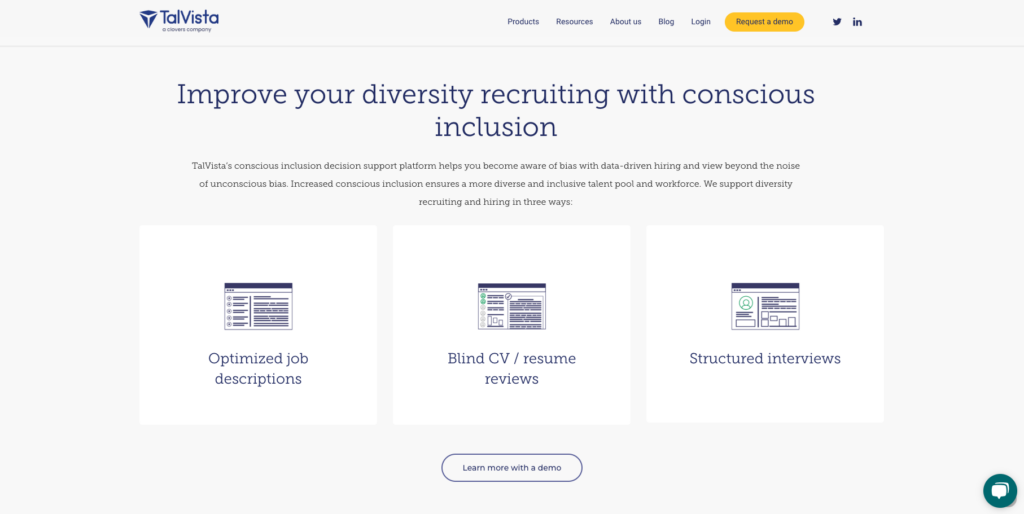
TalVista combines three tools for blind recruiting:
Inclusive job description optimizer
Anonymized resume screening tool
Structured interview design tool
TalVista’s job description generator flags non-inclusive language in your job descriptions and coaches your team to avoid problematic phrasing, like mentions of sexual orientation or personal interests that aren’t relevant to the role.
The redacted resume screening tool removes personally identifiable information from all the applicant documents so hiring managers can make more objective decisions. This shifts the focus on a candidate’s application from their name or cover letter to their skills and unique value as a potential team member.
The structured interview module provides interviewing questions and clear instructions tailored to assess candidates’ relevant skills. This helps hiring teams improve the hiring process and source the best talent by ensuring interviews or job descriptions are solely skills-based.
Pricing details are available on request.
6. Pymetrics

Pymetrics uses data-driven behavioral insights and audited AI to create a collection of neuroscience-based games for assessing candidates’ cognitive, problem-solving, and communication skills.
Rather than looking at cover letters or a job candidate’s personal information, they use gamified behavioral assessments to produce a personalized profile highlighting the candidates’ strengths and weaknesses. This profile benefits both candidates, who gain self-awareness and improvement insights, and companies, which can identify well-suited applicants for specific roles.
Users can also train custom AI algorithms to better identify applicants for internal mobility opportunities or upskilling opportunities.
Pricing details are available on request.
The benefits of blind hiring practices
While using blind hiring software can help facilitate diversity recruiting and combat unconscious bias, you might be wondering, “What else is in it for me and my company?”
If you’re asking yourself that, perhaps you haven’t understood the true power of blind hiring. There are numerous benefits of implementing a blind hiring process at every stage of the hiring process. Here are four of them.
1. Zapping unconscious bias
We’re all human, and consciously or not, we tend to favor people who remind us of ourselves. Unfortunately, this can lead to unintentional discrimination, which is most commonly referred to as unconscious bias in the hiring world.
Even the most well-trained hiring managers, regardless of their intent on improving diversity, bring implicit bias into the decision-making process. Until humans naturally learn to eliminate unconscious bias, blind hiring software helps make the recruitment process more fair.
Removing personal details from job applications keeps the focus on skills and qualifications, so the only bias is in favor of talent and the most qualified candidates.
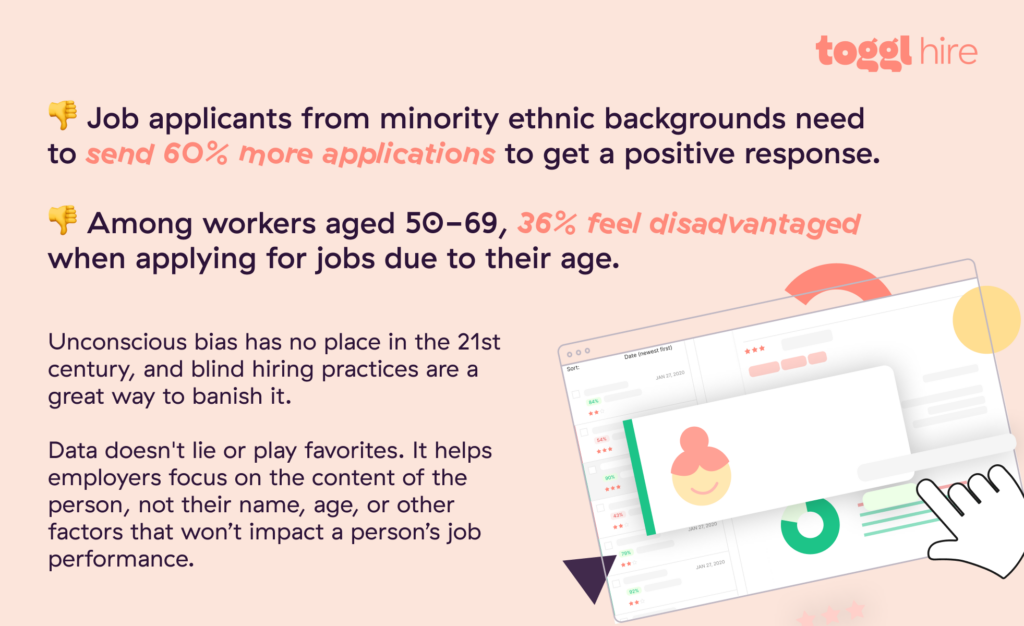
2. Boosting diversity
With personal details off the table, you’re opening the door to a broader talent pool of diverse candidates. Blind recruitment software helps ensure that candidates from all walks of life are given equal consideration based on their capabilities, not personal identity markers.
This allows hiring teams to bring fresh perspectives and diverse experiences to their companies, which can spark great ideas and innovation.
According to recent studies, working to improve diversity isn’t just great for your company culture; building a more diverse workforce is essential to building an innovative business.
3. Fair play in hiring
Nothing feels better than knowing your hiring process is fair and just. Blind recruitment software levels the playing field, and candidates are assessed based on their skills and qualifications alone.
In essence, blind hiring is the epitome of fair recruiting, ensuring decisions aren’t influenced by factors such as race, gender, or age.
This allows you to tap into a diverse pool of top candidates that includes minority groups and workers with non-traditional experience or job gaps who have the skills needed to make a real impact in their jobs.
4. Efficiency and cost savings
As an HR manager, you’ve got a lot on your plate, and working to increase diversity is only one of the tasks you juggle daily. You also likely face issues such as improving hiring time, ensuring a good candidate experience, and making data-driven recruitment decisions.
Blind recruitment software can automate the preliminary screening process, allowing you to focus on finding the best fit for the role. This saves significant time and leads to a more cost-effective hiring process.

How does blind hiring work?
If you want to implement blind hiring into your hiring process but aren’t sure how to start rebuilding your recruitment strategy around blind hiring software or similar hiring practices, here are a few tips to get you started.
1. Create better job postings
Take a good look at those job descriptions. They should spotlight only the essential qualifications and skills required for the role.
Be mindful of your language and keep job ads and descriptions neutral, avoiding language that may unintentionally discourage certain individuals from applying.
Using gender-neutral language and focusing on the candidate’s skills instead of a person’s background can not only help remove hidden biases in the hiring process but also help you attract diverse candidates who can make a significant impact in their roles.
2. Disguise personal details
With dozens of applications rolling in, it’s time to anonymize them all. With the help of blind hiring tools and other recruitment software, you can scrub personal identifiers like candidate names, addresses, graduation years, and even school names.
Instead of looking at what doesn’t matter (and what could potentially lead to hiring bias), each applicant gets their unique identifier or code. This way, you’re leveling the playing field, ensuring that every candidate gets assessed on skills and qualifications alone.
3. Skill-based assessments
Now, it’s time to introduce standardized skills assessments into the mix. These can be anything from coding tests for tech companies hiring senior software developers to sales pitches for software companies looking to fill sales positions.
The goal is to focus exclusively on applicants’ abilities, not their backgrounds. While skills-based hiring helps reduce bias, it also improves the quality of your hires, reduces the risk of making a bad hire, and can boost retention.
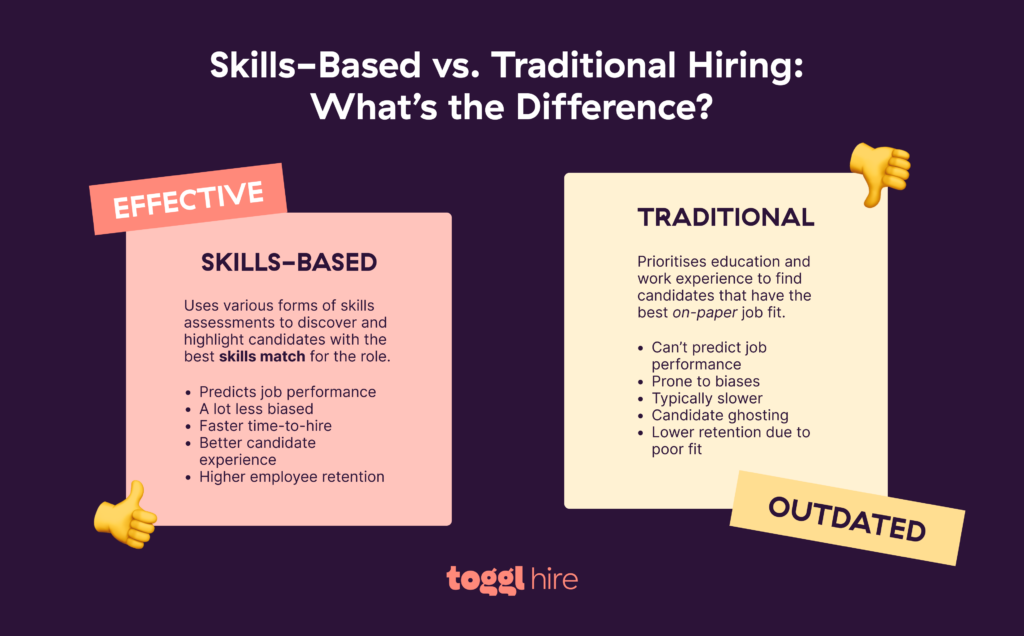
4. Structured interviews
Should the process progress to include interviews, it’s good practice to stick to a predetermined set of questions to ensure the hiring process is similar (if not exactly the same) for all candidates.
Some businesses implementing a truly blind hiring process even use voice modulation tools during phone interviews to mask hints of a candidate’s identity to focus squarely on capabilities.
5. Diversify your interview panels
Finally, when it comes to face-to-face interviews, ensure your panels are as diverse as possible. Having a range of perspectives can significantly reduce bias and ensure a more balanced selection process, ensuring you hire only the most qualified candidates.
Hire the best candidates
Blind recruitment software helps ensure you hire people for their skills, not their lofty credentials. Because with personal details off the table, you’re opening the door to a broader talent pool.
If you’re not ready to commit fully, implement progressive blind hiring by replacing resume screening with skills-based assessments. This strategy gives you more diverse hires and candidates and confidence in their fit for the role.
With Toggl Hire, candidates can take a short 5-10-minute skills-based quiz showing their practical knowledge and aptitude for the role they’re applying for. Learn more about how we do it by watching this 1-minute explainer video below, or view our skills test library.
Elizabeth is an experienced entrepreneur and content marketer. She has nine years of experience helping grow businesses and has experienced first-hand the impact of skills-based hiring in today's global, digital world.







